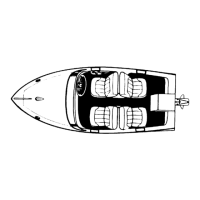CLOSED COOLING MODELS - 6B-3990-823225--1 1096
Cleaning Seawater Section of Heat
Exchanger and Fluid Coolers
During operation, contaminants in the seawater may
collect on tubes within the heat exchanger and fluid
coolers reducing their cooling efficiency. This will
cause coolant temperature to gradually rise until an
overheating condition exists. To prevent this from
happening, the seawater section of heat exchanger,
and fluid coolers should be cleaned at least once a
year or whenever a gradual rise in temperature is
observed on water temperature gauge. Clean sea-
water section of heat exchanger and coolers.
1. Refer to “Cold Weather or Extended Storage -
Seawater Section Draining Instructions” and
drain seawater section
.
2. Remove end cover, attaching screw, O-ring and
rubber gasket, from port and starboard ends of
heat exchanger.
71515
b
c
d
a
Starboard End Cover Shown (Port Similar)
a - End Cover
b - Screw
c - O-Ring
d - Rubber Gasket
3. Follow appropriate instructions “a” or “b”:
a. On Engines Without
Cool Fuel System:
Proceed to Step 4.
b. On Engines With
Cool Fuel System: Dis-
connect the fore and aft seawater hoses from
Cool Fuel System cooler.
74988
a
b
c
d
Typical Engine With Cool Fuel System
a - Cool Fuel System
b - Cooler of Cool Fuel System
c - Seawater Hose From Seawater Pump
d - Seawater Hose To Heat Exchanger
4. Disconnect hoses from ends of power steering
cooler.
75020
b
a
c
a - Power Steering Fluid Cooler
b - Seawater Hose From Seawater Pump
c - Seawater Hose To Heat Exchanger
5. Remove any debris from cavities on ends of heat
exchanger and fluid coolers.

